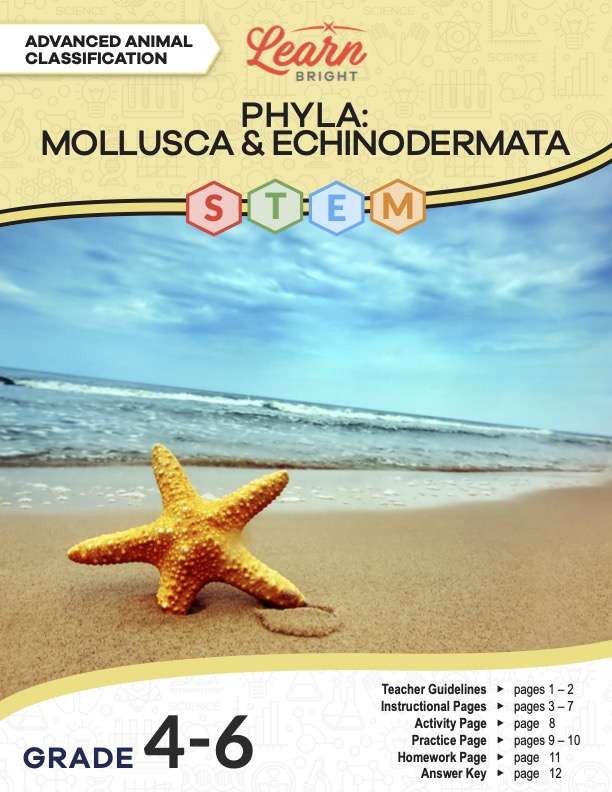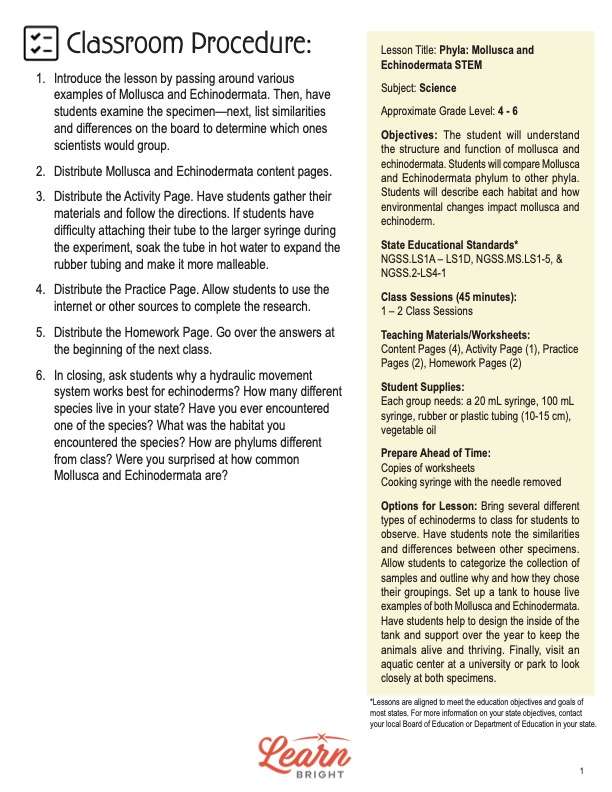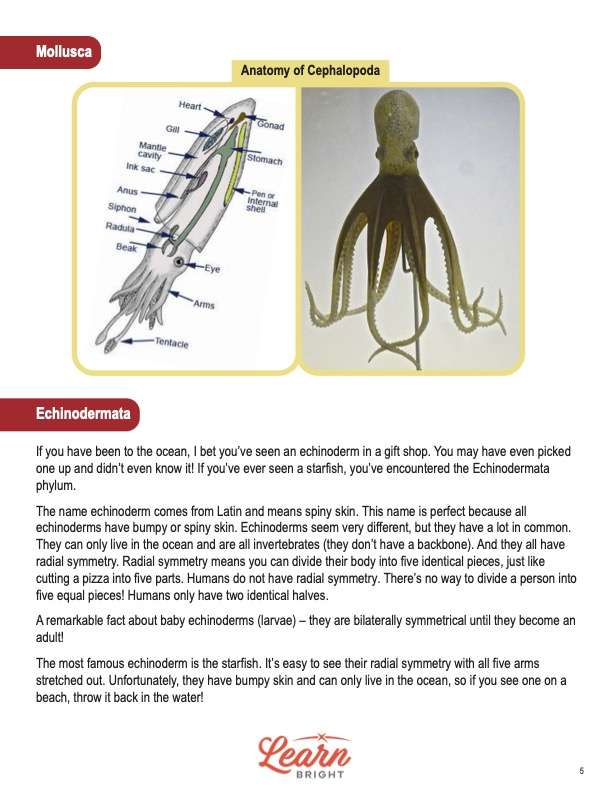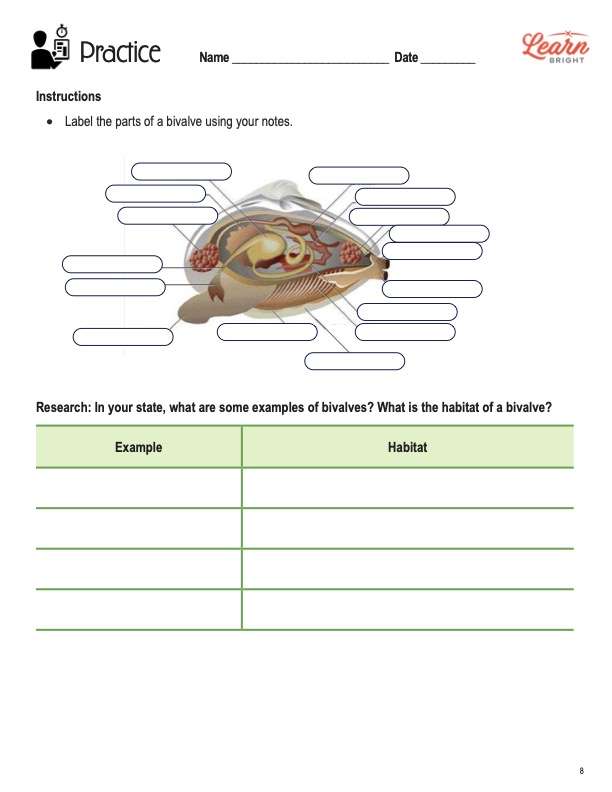Description
What our Phyla Mollusca and Echinodermata STEM lesson plan includes
Lesson Objectives and Overview: Phyla Mollusca and Echinodermata STEM teaches students about the animals within these two groups. Students will learn about and be able to explain the similarities and differences between the two. They will also discover which habitats and environments these various species live in. This lesson is for students in 4th grade, 5th grade, and 6th grade.
Classroom Procedure
Every lesson plan provides you with a classroom procedure page that outlines a step-by-step guide to follow. You do not have to follow the guide exactly. The guide helps you organize the lesson and details when to hand out worksheets. It also lists information in the yellow box that you might find useful. You will find the lesson objectives, state standards, and number of class sessions the lesson should take to complete in this area. In addition, it describes the supplies you will need as well as what and how you need to prepare beforehand. Some of the supplies you need to gather include syringes, rubber tubing, and vegetable oil.
Options for Lesson
You can check out the “Options for Lesson” section of the classroom procedure page for additional suggestions for ideas and activities to incorporate into the lesson. Bring several different types of echinoderms to class for students to observe. Have students note the similarities and differences between other specimens. Allow students to categorize the collection of samples and outline why and how they chose their groupings. Set up a tank to house live examples of both Mollusca and Echinodermata. Have students help to design the inside of the tank and support over the year to keep the animals alive and thriving. For one more activity, visit an aquatic center at a university or park to look closely at both types of specimens.
Teacher Notes
The teacher notes page provides an extra paragraph of information to help guide the lesson. You can use the blank lines to write down any other ideas or thoughts you have about the topic as you prepare.
PHYLA MOLLUSCA AND ECHINODERMATA STEM LESSON PLAN CONTENT PAGES
Mollusca
Phyla Mollusca and Echinodermata STEM lesson plan has four content pages. In biology, a phylum is a level of classification below kingdom and above class. A phylum is a group of related or similar organisms. Each phylum comprises several different classes. The second-largest animal phylum is Mollusca.
Scientists have discovered about 100,000 species of mollusks all over the world, but there are still many more out there we haven’t found. In fact, there are probably tens of thousands of undiscovered mollusks! These animals are either terrestrial (on the land) or aquatic (in the water). Most aquatic mollusks live in the salty ocean water, but some live in freshwater.
Mollusks are invertebrate animals, which means they do not have a backbone and are cold-blooded. Instead, their bodies are soft, so many will grow a hard shell to protect themselves. The shell will grow in either one or two pieces, and it will not have any joints like the exoskeletons of insects or crustaceans. Additionally, mollusks do not have any legs! But some will have tentacles for grabbing things or sensing the environment around them.
Types of Mollusks
We can classify mollusks into three main groups: gastropoda, bivalvia, and cephalopoda. Gastropods include all the snails and slugs. Bivalvia or bivalves include clams, oysters, and mussels. Finally, the cephalopoda group is home to species of squid and octopus.
Gastropoda is the most diverse group because tens of thousands of them exist. Almost every snail grows a shell that is one piece and spiraled. But some snails decided to stop growing a shell, and now we call them slugs!
A bivalve is mollusk with two shells like clams, oysters, and mussels. This helps them close super tight when danger is near to protect themselves.
A cephalopod only lives in salt water. Cephalopods don’t have any shells. They are more intelligent, faster, and much larger than other mollusks. You know them as squid and octopus. Squids and octopuses are predators because they eat fish, crustaceans, and even other mollusks!
Echinodermata
The name echinoderm comes from Latin and means spiny skin. This name is perfect because all echinoderms have bumpy or spiny skin. Echinoderms seem very different, but they have a lot in common. They can only live in the ocean and are all invertebrates. And they all have radial symmetry. Radial symmetry means you can divide their body into five identical pieces, just like cutting a pizza into five parts. Humans do not have radial symmetry. There is no way to divide a person into five equal pieces! Humans only have two identical halves.
A remarkable fact about baby echinoderms (larvae) is that they are bilaterally symmetrical until they become an adult. The most famous echinoderm is the starfish. It’s easy to see their radial symmetry with all five arms stretched out. Like all the other echinoderms, they have bumpy skin and can only live in the ocean.
Other Interesting Facts
On the underside of an echinoderm are tube feet. Tube feet are small tube-like projections that are part of an echinoderm’s water vascular system. The water vascular system is a system of fluid-filled canals extending along each body region. The tube feet help the echinoderm move, feed, and even breathe. Arranged along grooves in the arms, they operate through hydraulic pressure. For example, they can move food to their mouth using hydraulic pressure and attach it to surfaces. That’s how they stick to the ocean floor or the side of a tank in an aquarium.
Starfish use their tubed feet to open up bivalve shells. Bivalves are held closed by strong muscles, but starfish clamp hold of the bivalve with their tube feet and pull. The starfish applies steady pressure from both sides. Eventually, the bivalve can’t hold itself closed. It takes about 10 minutes for a starfish to pop open a bivalve just enough to insert its stomach. When the starfish slips its stomach into the shell, it can dissolve the mollusk and absorb the nutrients. While it only takes a few minutes to open the shell, it can take days for the starfish to digest the bivalve.
How do echinoderms protect themselves from predators? Some echinoderms have chemical defenses such as slime. Others have bad-tasting or toxic chemicals in their body wall. Most echinoderms have physical deterrents, such as spiny skin, to keep predators away. However, sea cucumbers are a bit different in their defense against predators. They will discharge a sticky thread to ensnare their enemies, contract their muscles, and shoot some of their internal organs at the predator. Yikes!
PHYLA MOLLUSCA AND ECHINODERMATA STEM LESSON PLAN WORKSHEETS
The Phyla Mollusca and Echinodermata STEM lesson plan includes three worksheets: an activity worksheet, a practice worksheet, and a homework assignment. Each one will help students solidify their grasp of the material they learned throughout the lesson. You can refer to the classroom procedure guidelines to know when to hand out each worksheet.
HYDRAULIC SYSTEM OF ECHINODERMATA ACTIVITY WORKSHEET
For the activity, students will demonstrate the hydraulic system of an echinodermata. They will fill syringes half full of vegetable oil, ensuring there are no bubbles that might affect the experiment. If bubbles form, students should push the oil out and redo the filling process. Students will insert the nozzle of the larger syringe into one end of the rubber tubing.
They will then push down on the syringe plunger until the vegetable oil almost reaches the end of the tubing. They should leave about a centimeter of empty tubing. Next, students will attach the other end of the tubing to the nozzle of the smaller syringe. Now they can operate the model by pushing down on one plunger and watching the other plunger rise.
Once they have completed the experiment, students will write down what they observed. The worksheet provides a scientific explanation for why this works.
BIVALVE RESEARCH PRACTICE WORKSHEET
The practice worksheet divides into two sections. For the first part, students will label the different parts of a bivalve using their notes. Then they will research examples of bivalves that are common to their state. They will also write about the different bivalves’ habitats.
PHYLA MOLLUSCA AND ECHINODERMATA STEM HOMEWORK ASSIGNMENT
Students will respond to five questions based on what they learned in the lesson. You could deliver this assignment as a quiz if you like.
Worksheet Answer Keys
The lesson plan document includes answer keys for the practice and homework worksheets. All the correct responses are in red to make it easy for you to compare them with your students’ work. There will be variation on the practice worksheet according to the state in which your students live. However, the answer key provides sample responses. If you choose to administer the lesson pages to your students via PDF, you will need to save a new file that omits these pages. Otherwise, you can simply print out the applicable pages and keep these as reference for yourself when grading assignments.










